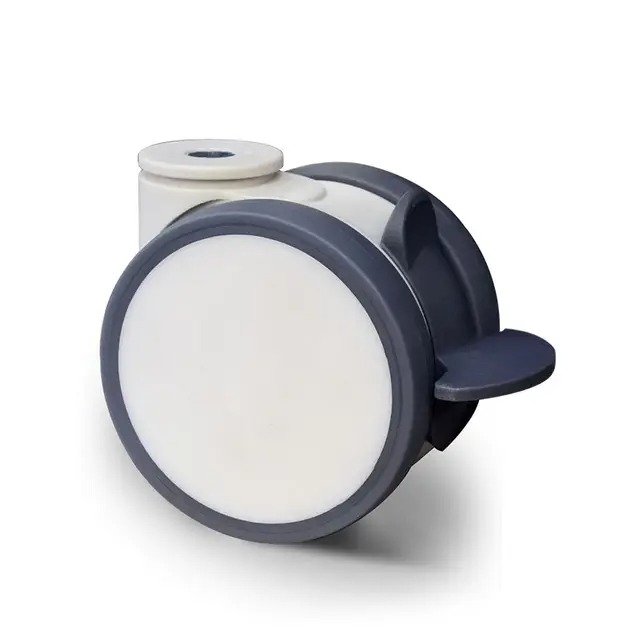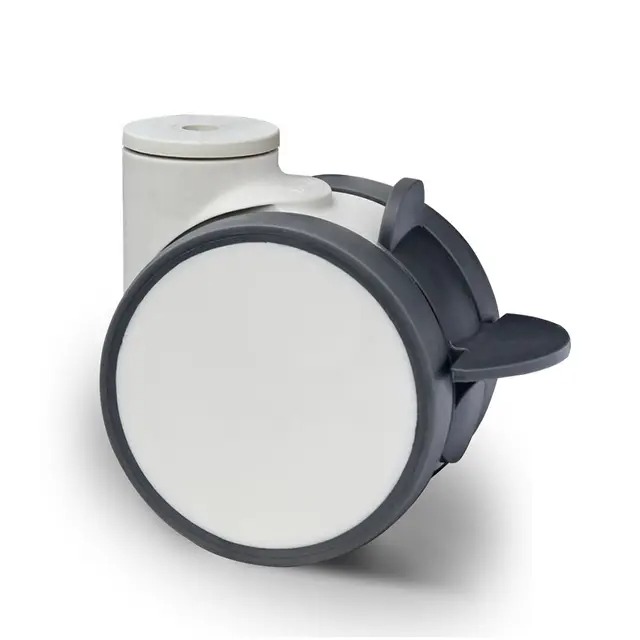Views: 194 Author: Site Editor Publish Time: 2025-06-13 Origin: Site

In the world of mobility and furniture flexibility, plastic castors have steadily gained popularity as an efficient, cost-effective, and lightweight solution. Their versatility makes them an indispensable component in both residential and commercial spaces. But what exactly makes plastic castors a smart choice for furniture mobility, and are they truly built to last?
Plastic castors are small wheel assemblies made primarily of high-grade plastic materials like polypropylene, nylon, or polyurethane. These castors are designed to be attached to the legs or base of furniture items, enabling easy movement without heavy lifting. Unlike traditional metal castors, plastic ones are lighter, more affordable, and often quieter during operation.
Plastic castors come in a wide variety of sizes, load capacities, and locking mechanisms. Some are designed for light-duty use, such as office chairs and drawer cabinets, while others are built for moderate loads like utility carts or small shelving units. Their main structure includes a wheel, a mounting component (plate or stem), and sometimes a brake system for added stability.
One of the key benefits of plastic castors is their resistance to corrosion and rust, making them ideal for indoor environments. Additionally, their non-marking nature ensures they won’t scratch or stain hardwood floors, tiles, or carpets. This makes them especially appealing for homeowners who prioritize both form and function in furniture design.
Plastic castors offer several compelling advantages when integrated into home and office furniture. Firstly, they are exceptionally lightweight. This not only makes the castor easy to install but also ensures that it doesn’t add unnecessary bulk to furniture items.
Secondly, they provide excellent floor protection. The soft, smooth plastic wheels minimize friction, which reduces the risk of floor damage — a common concern with metallic or rubber alternatives. Third, plastic castors are cost-effective. For mass-produced furniture like chairs, desks, or mobile drawers, this cost-efficiency plays a significant role in keeping manufacturing budgets in check.
Another notable advantage is the quiet mobility they offer. For instance, when used in a library or office space, plastic castors glide silently across the floor, maintaining a calm environment. Additionally, many plastic castors are designed with 360-degree rotation, enhancing maneuverability in tight or cluttered areas.
From a maintenance standpoint, plastic castors require very little upkeep. There’s no need for regular lubrication, and their synthetic composition makes them resistant to water damage or mild chemical exposure. For indoor applications, this makes them a reliable and practical long-term solution.
The usage scenarios of plastic castors are broader than many assume. In homes, they are commonly found on items like TV stands, laundry baskets, kitchen trolleys, and even under-bed storage drawers. Their ease of mobility allows users to quickly rearrange furniture for cleaning, decoration, or comfort.
In office environments, plastic castors play an equally important role. Most ergonomic office chairs are fitted with dual-wheel plastic castors that allow for smooth gliding on carpet or laminate surfaces. Filing cabinets and mobile pedestals often include lockable plastic castors, allowing for both mobility and secure placement.
Moreover, plastic castors are increasingly used in modern workspace furniture designs that support hot-desking or dynamic working zones. The ability to reconfigure spaces quickly without heavy lifting empowers productivity and collaborative setups.
Some manufacturers even use plastic castors in modular furniture systems. For example, tables or storage units designed for flexible learning environments in schools and colleges often feature plastic wheels to accommodate daily rearrangements.

Not all plastic castors are created equal. When selecting the right castors for a particular application, several important factors should be evaluated:
1. Load Capacity:
Different plastic castors are engineered for different weight ranges. Always check the maximum load capacity and consider a safety margin of 20–30%.
2. Wheel Diameter:
Larger wheels offer better mobility, especially over uneven surfaces. Smaller wheels, however, are ideal for compact furniture and smooth floors.
3. Mounting Type:
Castors are available with different mounts—plate, threaded stem, grip ring, etc. Ensure the mount is compatible with your furniture structure.
4. Braking Mechanism:
Some applications require a lockable wheel to prevent unwanted movement. This is crucial for safety and stability, especially in office settings.
5. Floor Compatibility:
Choose wheels that won’t scratch or damage your flooring. Non-marking wheels are best for hardwood, vinyl, or ceramic surfaces.
The table below summarizes key specifications to consider:
| Feature | Description |
|---|---|
| Load Rating | Ranges from 20 kg to over 100 kg per wheel |
| Wheel Diameter | Typically from 30mm to 100mm |
| Material Type | Polypropylene, Nylon, or PU |
| Brake Option | Available (single or dual lock) |
| Mounting Styles | Plate, stem, bolt-hole |
Q1: Are plastic castors durable enough for daily use?
Yes, most plastic castors are built for routine use. High-quality plastic like nylon or polyurethane ensures long-term durability, especially for light to medium-duty applications.
Q2: Can I use plastic castors on carpeted floors?
Absolutely. Dual-wheel plastic castors work particularly well on low- to medium-pile carpets. They allow easy movement without digging into the fabric.
Q3: Do plastic castors damage hardwood floors?
No. Most plastic castors are designed to be floor-safe. Non-marking variants are recommended for hardwood and laminate floors.
Q4: How can I replace or install a plastic castor?
Installation depends on the mount type. For stem-type castors, you simply insert them into a compatible socket. For plate types, screws or bolts are used for secure attachment.
Q5: Are plastic castors recyclable?
Some plastic castors can be recycled, depending on the material. However, mixed components (like metal stems and plastic wheels) may require disassembly.

As the demand for flexible living and working spaces continues to grow, furniture designs must evolve to accommodate these changes. Plastic castors play a central role in this transformation. Their lightweight nature, cost-effectiveness, and quiet performance make them an ideal choice for modern interiors.
Moreover, advancements in plastic engineering now allow manufacturers to produce stronger, more resilient castors capable of bearing heavier loads without compromising mobility or aesthetics. With sustainability also becoming a crucial consideration, many companies are exploring bio-based or recyclable plastics for future castor designs.
In summary, plastic castors offer a perfect balance between functionality, affordability, and design adaptability. Whether you’re furnishing a cozy home office or outfitting a busy co-working space, these small components can make a big difference.